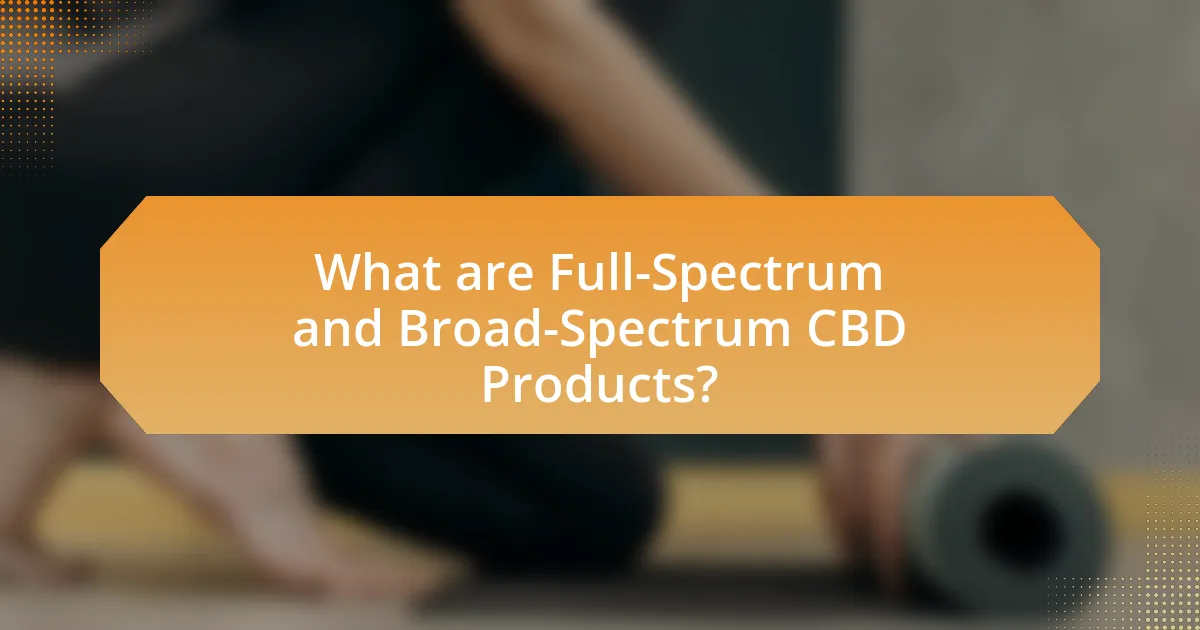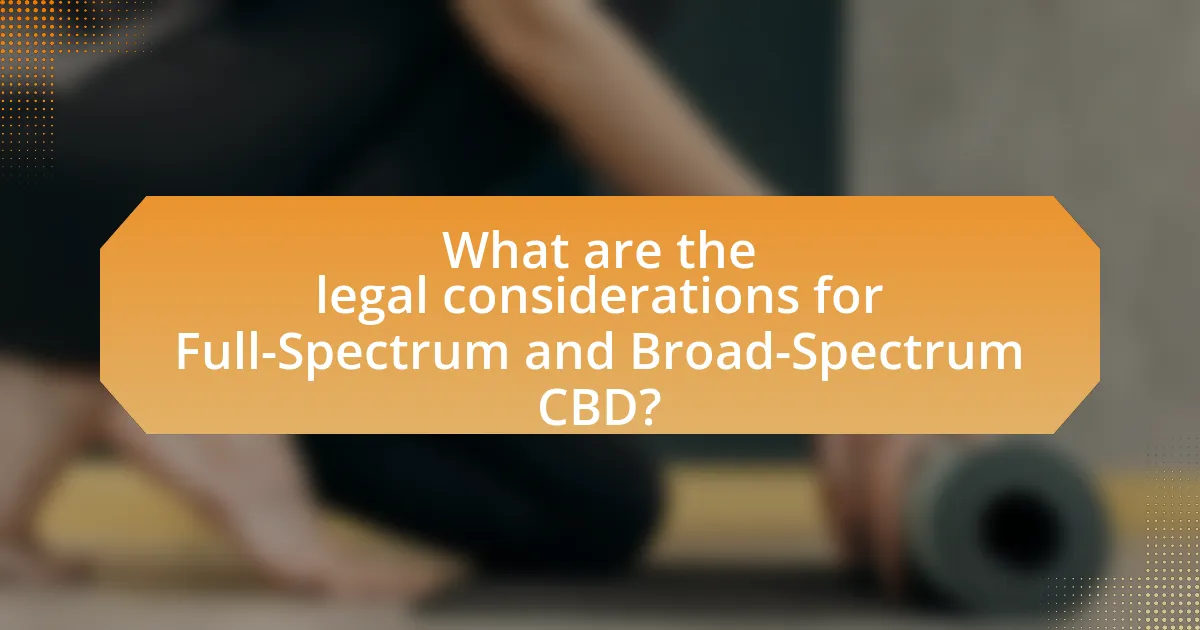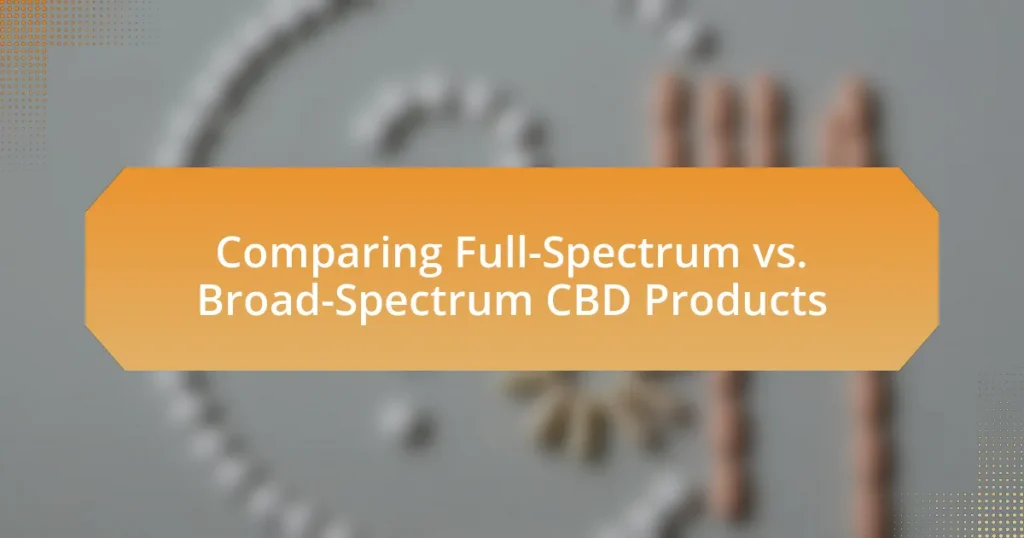Full-Spectrum and Broad-Spectrum CBD products are two distinct categories of cannabidiol offerings derived from the cannabis plant. Full-Spectrum CBD contains all cannabinoids, terpenes, and compounds, including trace amounts of THC, which may enhance therapeutic effects through the entourage effect. In contrast, Broad-Spectrum CBD includes multiple cannabinoids and terpenes but is completely THC-free, making it suitable for users who wish to avoid psychoactive effects. This article explores the differences between these two types of CBD products, their potential benefits, legal considerations, and best practices for use, providing consumers with essential information to make informed choices based on their health needs and preferences.

What are Full-Spectrum and Broad-Spectrum CBD Products?
Full-Spectrum CBD products contain all cannabinoids, terpenes, and other compounds found in the cannabis plant, including THC, which is present in trace amounts (up to 0.3% by federal law). This combination is believed to create an “entourage effect,” enhancing the therapeutic benefits of CBD. In contrast, Broad-Spectrum CBD products include multiple cannabinoids and terpenes but are specifically formulated to remove THC entirely. This allows users to experience the benefits of various compounds without the psychoactive effects associated with THC. The distinction between these two types of products is crucial for consumers seeking specific effects or avoiding THC for personal or legal reasons.
How do Full-Spectrum and Broad-Spectrum CBD products differ?
Full-Spectrum CBD products contain all cannabinoids, terpenes, and other compounds found in the cannabis plant, including THC, while Broad-Spectrum CBD products contain multiple cannabinoids and terpenes but exclude THC entirely. This distinction is significant because Full-Spectrum products may provide an “entourage effect,” where the various compounds work synergistically to enhance therapeutic benefits, whereas Broad-Spectrum products offer similar benefits without the psychoactive effects of THC. Studies indicate that the presence of THC in Full-Spectrum products can enhance pain relief and anxiety reduction, making them potentially more effective for certain users.
What cannabinoids are present in Full-Spectrum CBD products?
Full-Spectrum CBD products contain a variety of cannabinoids, including cannabidiol (CBD), tetrahydrocannabinol (THC), cannabigerol (CBG), cannabinol (CBN), and cannabichromene (CBC). These cannabinoids work synergistically to enhance the therapeutic effects of the product, a phenomenon known as the “entourage effect.” Research indicates that the presence of THC in full-spectrum products is typically below 0.3%, complying with legal standards while still contributing to the overall efficacy of the formulation.
What cannabinoids are present in Broad-Spectrum CBD products?
Broad-Spectrum CBD products contain a variety of cannabinoids, including cannabidiol (CBD), cannabichromene (CBC), cannabigerol (CBG), and trace amounts of tetrahydrocannabinol (THC), typically below 0.3%. These cannabinoids work together to enhance the therapeutic effects of the product without the psychoactive effects associated with higher THC levels. The presence of multiple cannabinoids in Broad-Spectrum CBD is supported by studies indicating that the entourage effect can enhance the overall efficacy of the product, making it a popular choice for users seeking the benefits of cannabinoids without the intoxicating effects of THC.
What are the potential benefits of Full-Spectrum CBD products?
Full-Spectrum CBD products offer a range of potential benefits, including enhanced therapeutic effects due to the presence of multiple cannabinoids, terpenes, and flavonoids. This entourage effect suggests that the combined compounds work synergistically, potentially improving efficacy in managing conditions such as anxiety, chronic pain, and inflammation. Research published in the Journal of Pain Research indicates that Full-Spectrum CBD may provide greater relief from pain compared to isolated CBD, highlighting its effectiveness in pain management. Additionally, Full-Spectrum products may promote better sleep quality and reduce symptoms of stress, as supported by studies showing improved sleep patterns in users.
How does the entourage effect enhance Full-Spectrum CBD’s benefits?
The entourage effect enhances Full-Spectrum CBD’s benefits by allowing various cannabinoids, terpenes, and flavonoids to work synergistically, resulting in a more potent therapeutic effect than isolated compounds. Research indicates that this synergy can improve the efficacy of CBD, as demonstrated in a study published in the British Journal of Pharmacology, which found that the combination of cannabinoids and terpenes can lead to enhanced anti-inflammatory and analgesic effects compared to CBD alone. This collaborative interaction among the compounds in Full-Spectrum CBD maximizes its potential health benefits, making it more effective for conditions such as anxiety, pain, and inflammation.
What conditions may Full-Spectrum CBD help alleviate?
Full-Spectrum CBD may help alleviate conditions such as chronic pain, anxiety, depression, inflammation, and epilepsy. Research indicates that the presence of multiple cannabinoids and terpenes in Full-Spectrum CBD enhances its therapeutic effects through the entourage effect, which suggests that these compounds work synergistically to provide greater relief than isolated cannabinoids alone. For instance, a study published in the Journal of Pain Research found that CBD significantly reduced pain and improved sleep quality in patients with chronic pain conditions.
What are the potential benefits of Broad-Spectrum CBD products?
Broad-Spectrum CBD products offer several potential benefits, including relief from anxiety, pain management, and anti-inflammatory effects. These products contain a range of cannabinoids, excluding THC, which allows users to experience the therapeutic effects without the psychoactive properties associated with THC. Research indicates that cannabinoids work synergistically, enhancing the overall effectiveness of the product, a phenomenon known as the “entourage effect.” A study published in the Journal of Pain Research found that CBD can significantly reduce chronic pain and improve sleep quality, supporting the claims of its efficacy in pain management and anxiety relief.
How does Broad-Spectrum CBD provide benefits without THC?
Broad-Spectrum CBD provides benefits without THC by retaining various cannabinoids, terpenes, and flavonoids while excluding THC. This composition allows users to experience the entourage effect, where the combined action of these compounds enhances the therapeutic potential of CBD. Research indicates that cannabinoids like CBD, CBG, and CBN can work synergistically to promote relief from anxiety, inflammation, and pain, even in the absence of THC. For instance, a study published in the Journal of Pain Research found that CBD can significantly reduce pain and improve sleep quality, demonstrating its effectiveness without the psychoactive effects associated with THC.
What conditions may Broad-Spectrum CBD help alleviate?
Broad-Spectrum CBD may help alleviate conditions such as anxiety, chronic pain, inflammation, and epilepsy. Research indicates that CBD interacts with the endocannabinoid system, which plays a crucial role in regulating mood and pain perception. A study published in the Journal of Clinical Psychology found that CBD significantly reduced anxiety levels in participants, demonstrating its potential effectiveness for anxiety disorders. Additionally, a review in the journal Pain found that CBD can reduce chronic pain and inflammation, supporting its use in pain management.

What are the legal considerations for Full-Spectrum and Broad-Spectrum CBD?
Full-Spectrum and Broad-Spectrum CBD products are subject to varying legal considerations primarily based on their THC content. Full-Spectrum CBD contains up to 0.3% THC, which is federally legal under the 2018 Farm Bill, provided it is derived from hemp. However, some states impose stricter regulations, potentially prohibiting any THC content. Broad-Spectrum CBD, which contains no THC, is generally more widely accepted and faces fewer legal restrictions. Compliance with state laws is crucial, as they can differ significantly; for instance, states like Idaho and South Dakota have stricter regulations regarding CBD products. Therefore, understanding both federal and state laws is essential for legal compliance when dealing with Full-Spectrum and Broad-Spectrum CBD.
How does the legality of THC affect Full-Spectrum CBD products?
The legality of THC directly impacts Full-Spectrum CBD products by determining their permissible THC content. In the United States, the 2018 Farm Bill legalized hemp-derived CBD products containing less than 0.3% THC, allowing Full-Spectrum CBD products to be sold legally in states where hemp is permitted. This legal threshold means that Full-Spectrum CBD can include a range of cannabinoids, including THC, which may enhance the therapeutic effects through the entourage effect. However, in states where THC remains illegal, the sale and distribution of Full-Spectrum CBD products may be restricted or prohibited, affecting market availability and consumer access.
What are the legal limits for THC in Full-Spectrum CBD products?
The legal limit for THC in Full-Spectrum CBD products is 0.3% on a dry weight basis, as established by the 2018 Farm Bill in the United States. This legislation defines hemp as cannabis containing no more than 0.3% THC, allowing Full-Spectrum CBD products to include this level of THC while remaining compliant with federal regulations. The 0.3% threshold is crucial for differentiating hemp from marijuana, which is classified differently under the law.
How do regulations differ for Broad-Spectrum CBD products?
Regulations for Broad-Spectrum CBD products primarily differ from those for Full-Spectrum CBD products in terms of THC content. Broad-Spectrum CBD is defined as containing multiple cannabinoids, excluding THC, which allows it to comply with federal regulations that mandate CBD products contain less than 0.3% THC. This distinction is crucial because it enables Broad-Spectrum CBD to be marketed in states with stricter cannabis laws, where THC presence may be prohibited. Additionally, the lack of THC in Broad-Spectrum products often leads to fewer restrictions in terms of labeling and marketing compared to Full-Spectrum products, which must navigate more complex legal frameworks due to their THC content.
What should consumers know about sourcing and quality?
Consumers should know that sourcing and quality directly impact the efficacy and safety of CBD products. High-quality CBD is typically sourced from organically grown hemp, which ensures minimal exposure to pesticides and heavy metals. For instance, a study published in the Journal of Cannabis Research highlights that hemp cultivated under organic standards contains higher levels of beneficial cannabinoids and terpenes, enhancing the therapeutic potential of full-spectrum and broad-spectrum products. Additionally, consumers should look for third-party lab testing results, which verify the cannabinoid content and confirm the absence of harmful substances, ensuring that the product meets safety and quality standards.
How can consumers verify the quality of Full-Spectrum CBD products?
Consumers can verify the quality of Full-Spectrum CBD products by checking for third-party lab testing results. Reputable manufacturers provide Certificates of Analysis (COAs) that detail the cannabinoid profile, potency, and the presence of contaminants such as pesticides or heavy metals. These COAs are typically accessible on the brand’s website or upon request. According to a 2021 study published in the Journal of Cannabis Research, products that undergo third-party testing are more likely to meet safety and quality standards, ensuring consumers receive what is advertised.
What quality indicators should consumers look for in Broad-Spectrum CBD products?
Consumers should look for third-party lab testing, clear ingredient labeling, and the presence of cannabinoids in Broad-Spectrum CBD products. Third-party lab testing ensures that the product has been independently verified for potency and purity, confirming that it contains the claimed amount of CBD and is free from harmful contaminants. Clear ingredient labeling allows consumers to understand what is in the product, including the types and amounts of cannabinoids present, which is crucial for assessing its effectiveness. Additionally, the presence of multiple cannabinoids, excluding THC, indicates a broader range of therapeutic benefits, as supported by research showing that cannabinoids can work synergistically to enhance effects.

How do Full-Spectrum and Broad-Spectrum CBD products fit into wellness routines?
Full-Spectrum and Broad-Spectrum CBD products fit into wellness routines by providing various therapeutic benefits without the psychoactive effects associated with THC. Full-Spectrum CBD contains all cannabinoids, terpenes, and flavonoids found in the cannabis plant, which can enhance the entourage effect, potentially improving overall wellness. Broad-Spectrum CBD, on the other hand, includes multiple cannabinoids and terpenes but is THC-free, making it suitable for individuals who want to avoid THC while still benefiting from other compounds. Research indicates that both types can help with stress relief, pain management, and improved sleep quality, thus integrating seamlessly into daily wellness practices.
What are the best practices for using Full-Spectrum CBD products?
The best practices for using Full-Spectrum CBD products include starting with a low dose, gradually increasing as needed, and monitoring effects closely. Users should consider their individual body chemistry and health conditions, as Full-Spectrum CBD contains various cannabinoids, terpenes, and trace amounts of THC, which can enhance effects through the entourage effect. Research indicates that starting low and going slow helps in finding the optimal dosage while minimizing potential side effects. Additionally, consulting with a healthcare professional before use is advisable, especially for individuals taking other medications, to avoid interactions.
How should dosage be determined for Full-Spectrum CBD?
Dosage for Full-Spectrum CBD should be determined based on individual factors such as body weight, metabolism, and the specific condition being treated. Research indicates that a common starting dose is 1-6 mg of CBD per 10 pounds of body weight, adjusted according to the user’s response and tolerance. For instance, a person weighing 150 pounds might start with a dose between 15-90 mg of CBD daily, gradually increasing as needed. This approach is supported by studies showing that personalized dosing can enhance efficacy and minimize side effects, emphasizing the importance of monitoring individual reactions to the compound.
What are common methods of consumption for Full-Spectrum CBD?
Common methods of consumption for Full-Spectrum CBD include tinctures, capsules, edibles, topicals, and vaping. Tinctures are liquid extracts taken sublingually for quick absorption, while capsules provide a convenient, pre-measured dose. Edibles, such as gummies, offer a tasty way to consume CBD, though they may take longer to take effect. Topicals are applied directly to the skin for localized relief, and vaping allows for rapid delivery into the bloodstream. Each method caters to different preferences and desired effects, making Full-Spectrum CBD versatile for users.
What are the best practices for using Broad-Spectrum CBD products?
The best practices for using Broad-Spectrum CBD products include starting with a low dose, gradually increasing as needed, and monitoring effects closely. Users should consult with a healthcare professional before beginning use, especially if they are on other medications, to avoid potential interactions. Additionally, it is important to choose high-quality products that provide third-party lab testing results, ensuring the absence of THC and verifying cannabinoid content. Research indicates that starting low and going slow can help individuals find their optimal dosage while minimizing side effects.
How should dosage be determined for Broad-Spectrum CBD?
Dosage for Broad-Spectrum CBD should be determined based on individual factors such as body weight, metabolism, and the specific condition being addressed. Research indicates that a common starting dosage is 1-6 mg of CBD per 10 pounds of body weight, adjusted according to the user’s response and tolerance. For example, a person weighing 150 pounds may start with a dosage of 15-90 mg per day, gradually increasing as needed. This approach is supported by studies that suggest personalized dosing leads to optimal therapeutic effects while minimizing side effects.
What are common methods of consumption for Broad-Spectrum CBD?
Common methods of consumption for Broad-Spectrum CBD include tinctures, capsules, edibles, topicals, and vaping. Tinctures are liquid extracts taken sublingually for quick absorption, while capsules offer a convenient, pre-measured dose. Edibles, such as gummies, provide a tasty way to consume CBD, and topicals allow for localized application on the skin. Vaping delivers CBD rapidly through inhalation. Each method caters to different preferences and desired effects, making Broad-Spectrum CBD versatile for users.
What tips can help consumers choose between Full-Spectrum and Broad-Spectrum CBD?
Consumers can choose between Full-Spectrum and Broad-Spectrum CBD by considering their individual health needs and preferences. Full-Spectrum CBD contains all cannabinoids, including THC, which may enhance therapeutic effects through the entourage effect, while Broad-Spectrum CBD includes multiple cannabinoids but is THC-free, making it suitable for those who want to avoid THC entirely. Additionally, consumers should evaluate the product’s lab testing results for potency and purity, as well as their own sensitivity to THC, to make an informed decision that aligns with their wellness goals.



